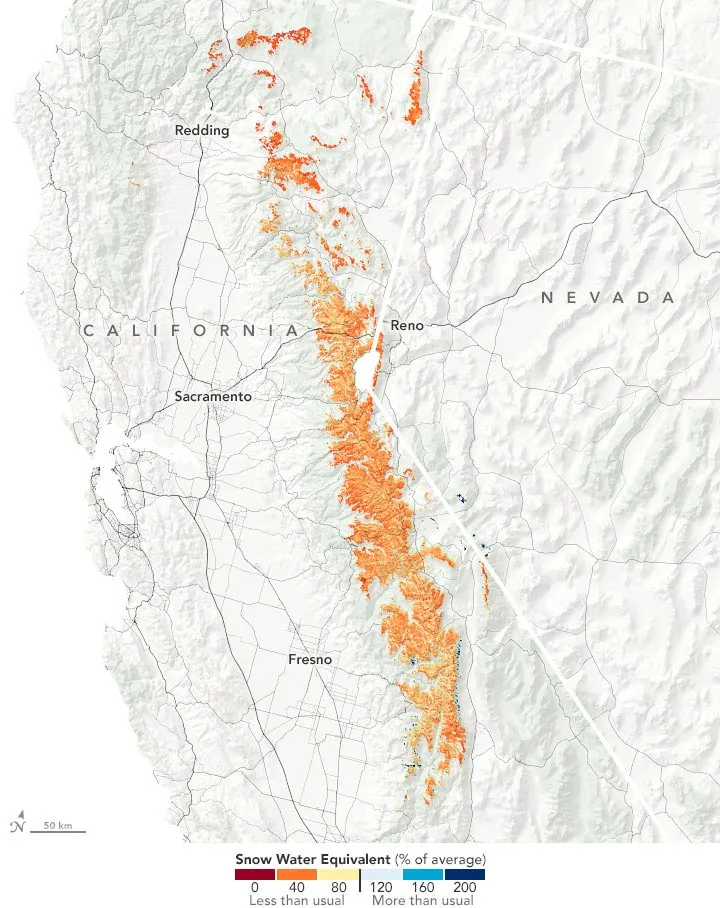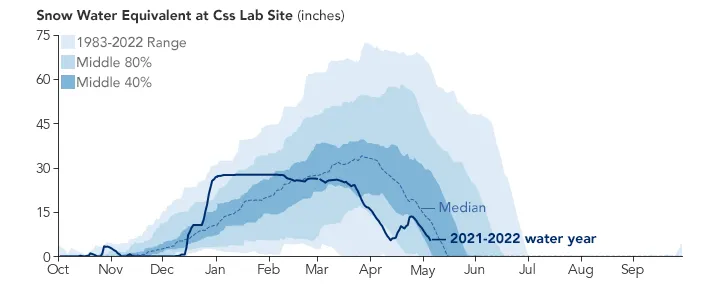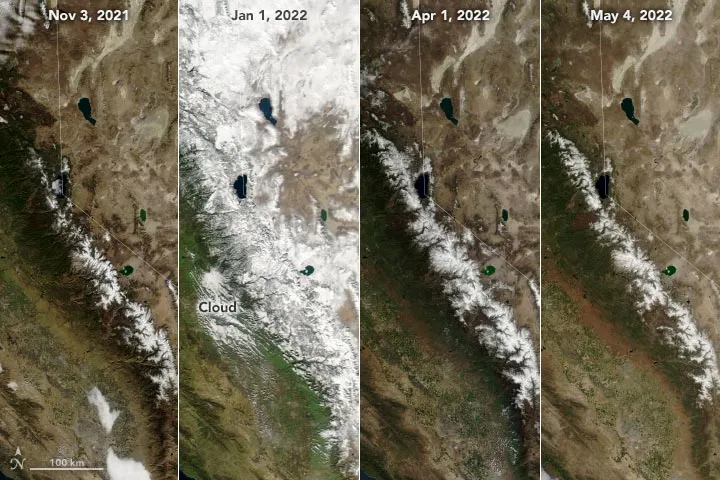The snow in the Sierra Nevada is known for its obvious fluctuations: one year can be particularly bad, and the next year can be unusually good. However, in 2021-22, there are high and low levels in the same snow season The result is another year of insufficient snowfall, raising concerns about the impact of water supply
Noah Moloch, a mountain hydrologist at the Arctic and Alps Institute (INSTAAR) and NASA's Jet Propulsion Laboratory (JPL), said: "the Sierra mountains tend to have big storms, a lot of snow is erupting, or we get little snow. We have a actually average snow year, which is rare."

Every winter, the snow falling on the Sierra Nevada becomes a natural reservoir, which melts slowly in spring and summer and flows to the valley. In a typical year, this snow accounts for about 30% of California's water supply. Resource managers rely on this melting snow to replenish the reservoir with enough water to cope with the typical dry months of summer and autumn.
"The past winter has been an extreme of the overall downward trend. These are natural events that can occur under normal circumstances, but global warming has amplified everything. The trajectory of climate change has put us on a path, and the normal winter crazy fluctuations have now become distorted madness," Moloch said
The saw saw patterns of rainfall and snowfall on the west coast of North America are sometimes related to El Ni ñ O and La Ni ñ a models - these models change the atmospheric circulation in the tropics and mid latitudes, and are related to atmospheric rivers that occasionally transport water from the tropical Pacific to California. Over the past few years, La Nina has continued to occur in the tropical Pacific, which tends to make some areas drier. At the same time, warming global temperatures and changing jets have brought more frequent sunny and dry weather to the mountains.
The result is a significant reduction in snow cover in 2022. The Sierra Nevada snow water equivalent (SWE) shows this deficit, which is a measure of how much water you will get if all the snow in a particular area melts at one time. According to the California Department of water resources (ca-dwr), the snow water equivalent of the Sierra Nevada on April 1 was only 37% of the long-term average.

After the dry snow season began in November, December 2021 brought 70% of the annual average snowfall in just one month. According to the calculation of ca-dwr, the snow water equivalent on December 30 is 160% of the normal. But then the flow was shut down because the region experienced the driest January February March ever and the temperature was unusually warm. The heat wave in March 2022 caused the snow to melt prematurely, and the dryness continued until mid April. Then several end of season storms brought a temporary increase in the snow in the mountains. By May 5, 2022, ca-dwr reported that the snow water equivalent of the whole mountain range had fallen back to 27% of the normal.
The line chart above shows the patterns of high and low observed in the Donner pass, the seat of the central mountain snow Laboratory (CSS laboratory), which is one of the oldest snow measurement businesses in the mountains. In the 39 year record, the peak (dotted line) of snow water equivalent usually appears around March 24, with a median of 37.2 inches. In 2022, SWE peaked at 27.6 inches on January 12 and began to decline on February 6. The data in the figure is from the snotel network, which is managed by the U.S. Department of agriculture. In California, some water, research and power agencies track the ups and downs of mountain snow.
Natural color satellite images (below) can widely show the progress of the snow season and help scientists assess the coverage of snow. But they provide little information about the depth of snow. Although snotel and other monitoring networks provide some of the longest daily records of snow depth and water content in the past four decades, these measurements come from individual sites and are mostly in a narrow altitude range.

In order to fill the gap in our understanding of snow water in high-altitude areas and wider geographical areas, researchers have been developing tools to infer and interpolate snow volume. The map at the top of this page is such an effort.
According to the data provided by Moloch and INSTAAR colleagues Leanne lestak and Kehan Yang, the experimental product describes the snow water equivalent on April 24, 2022 and their comparison with the long-term average of the mountain range. The snow water equivalent is estimated from 20 years of NASA satellite data, snotel records, terrain information and computer modeling. The seed round funding for the product was originally provided by NASA's applied science program and is now supported by ca-dwr.
As reported by INSTAAR on April 24, the average swe percentage above 5000 feet above sea level is the highest in the central Sierra Nevada (61%), then in the North (47%), and the lowest in the South (41%). Just a week later, these figures fell to 42% in the central Sierra Nevada, 33% in the South and 26% in the north.
Benjamin Hatchett, a hydro climatologist at the desert Institute who studies snow disasters, said: "our natural water towers are becoming leaky. If the snow is melting ahead of time, it means that water is flowing out of our natural mountain reservoirs ahead of time. It also means that we have to manage it downstream, and we may not have the flexibility we want."
"Extreme precipitation events that can build snowdrifts well - such as last December - will become less favorable because we may have more rain falling instead of snow," Hatchett added. "Warming and drying will lead to more snow free days, and the snow will begin to melt in advance. With the continuous change of climate, how will the hydrology of surface and groundwater cope with low snow conditions, single extreme years and continuous dry years? We really need a better set of observation tools and modeling system from atmosphere to bedrock to understand these changes."